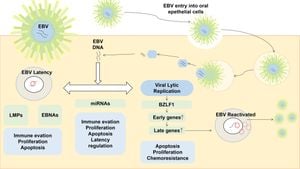The recent classification of the koala as endangered across much of its native range has underscored the pressing need for comprehensive disease surveillance. A significant discovery has emerged concerning phascolarctid gammaherpesvirus 2 (PhaHV-2), which appears to impact the wellbeing of these beloved marsupials. New research conducted by the University of Sydney and supported by wildlife and veterinary experts has provided valuable insights on the virus's distribution and transmission dynamics.
PhaHV-2 is now understood to extend beyond previously studied regions, reaching koala populations throughout New South Wales, Queensland, and South Australia. This finding is particularly concerning as the national koala population has plummeted from millions to around 330,000, with threats from habitat loss and disease exacerbated by the devastating bushfire season of 2019/20.
The researchers developed and applied a novel quantitative polymerase chain reaction (qPCR) assay, noted for its high sensitivity and specificity, to facilitate rapid detection and quantification of PhaHV-2. "Our assay enables us to characterize the distribution of PhaHV-2 effectively," mentioned the authors of the article.
The study analyzed 157 urogenital swab samples primarily derived from clinically affected koalas. It uncovered alarming statistics: the highest frequency of PhaHV-2 detection was reported at 25% among South Australian koalas, whereas northern Queensland reported no detections. Interestingly, the results indicated older koalas were much more likely to shed the virus than younger individuals.
Prior studies primarily focused on PhaHV-1, with minimal research done on PhaHV-2. This new research fills such gaps, reinforcing the need to understand the viral interaction dynamics and clinical significance associated with these gammaherpesviruses.
The findings suggest widespread distribution of PhaHV-2, challenging the perception of it being low-risk. The authors emphasized, "While PhaHV-2 is classified as low risk, the low certainty attached to this assessment highlights the urgent need for thorough evaluation of its role in koala disease." This aligns with the plight of koalas facing additional threats from chlamydial diseases, often aggravated by co-infection with other pathogens.
The data reveal compelling correlations between PhaHV-2 presence and the co-occurrence of PhaHV-1, with no significant association with clinical signs of chlamydial infection. This signals potential inter-viral interactions worth investigating. "PhaHV-2 detection was more likely in older koalas than younger koalas,” the authors stated. This raises questions around transmission dynamics, possibly hinting at horizontal transmission among older populations.
This research is more than just about detecting viruses. It's pivotal for conservation and wildlife health policies aimed at endangered koala populations. Creating effective strategies for isolations and minimizing co-infections could significantly alleviate the negative impacts of these diseases on koalas. The researchers call for future clinical studies to include broader geographic sampling and comprehensive health data to aid conservation efforts.
Addressing PhaHV-2 and related diseases must be part of the broader strategy to protect koalas from extinction. While current data illuminates some of the virus’s dynamics, more work is needed to understand its full impact on koala health and conservation.



